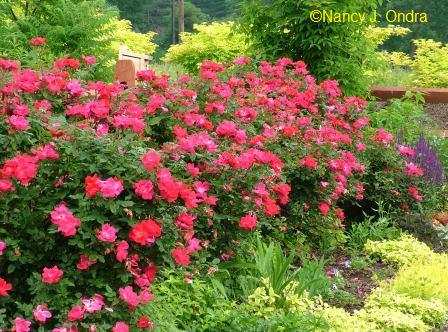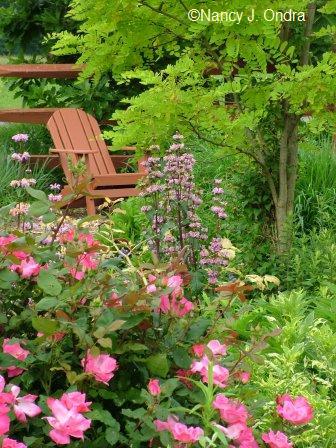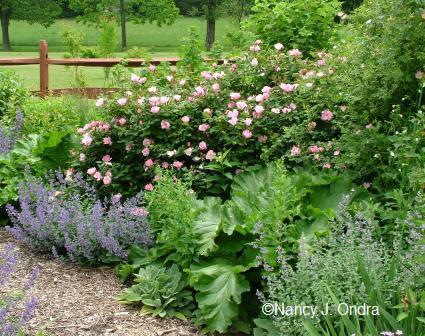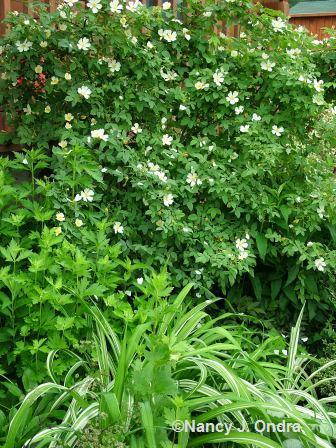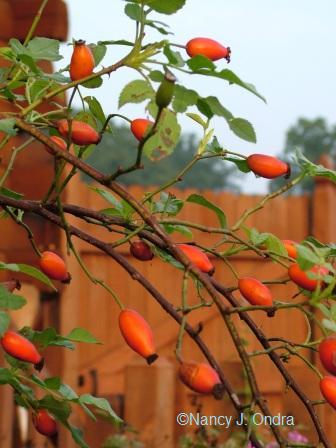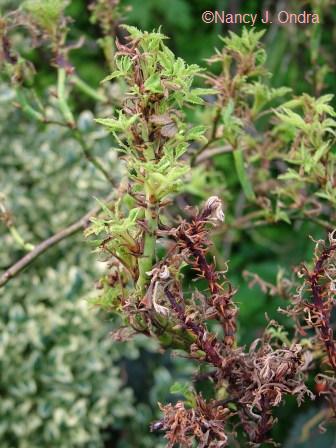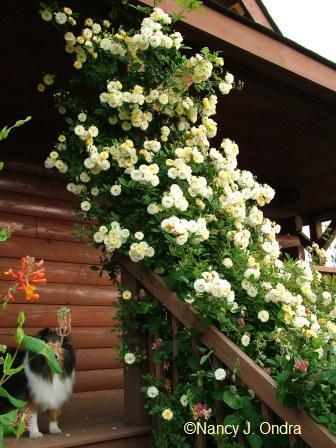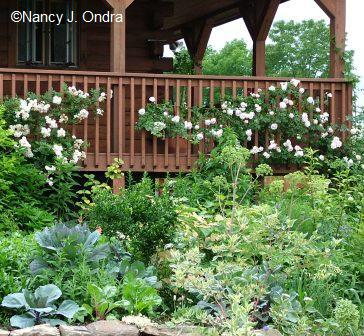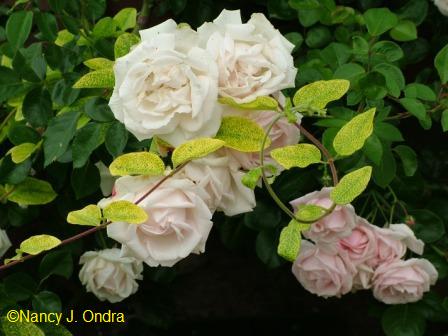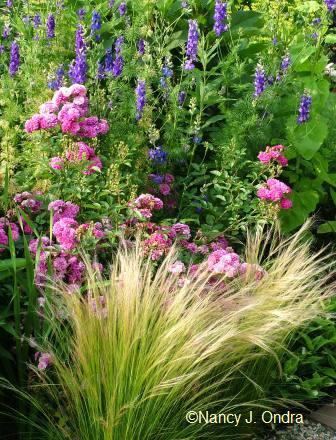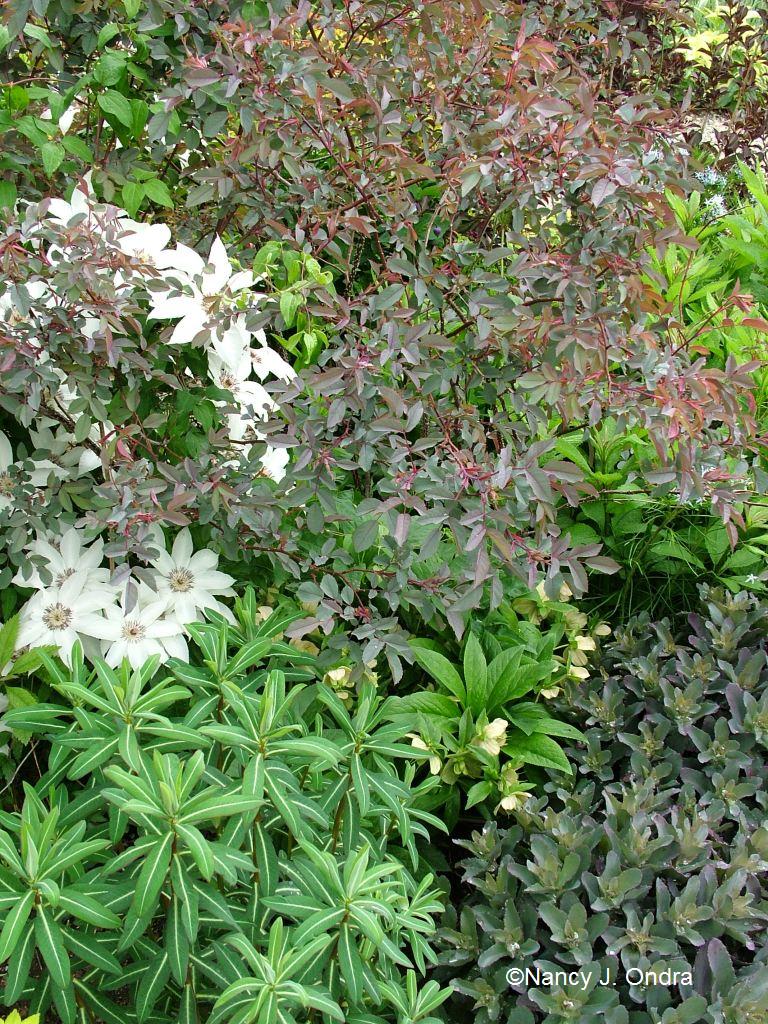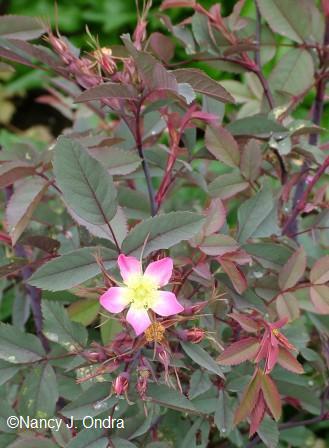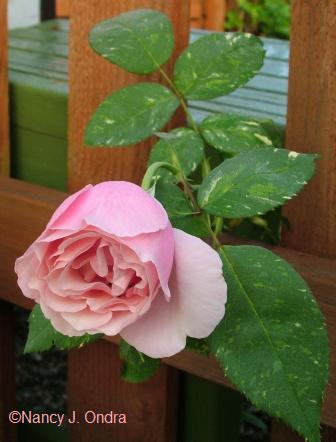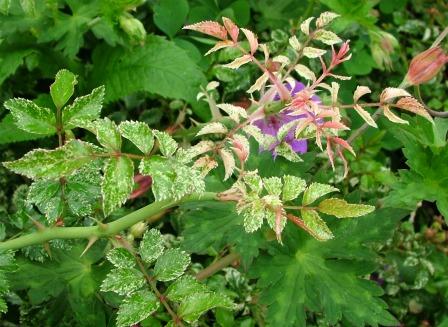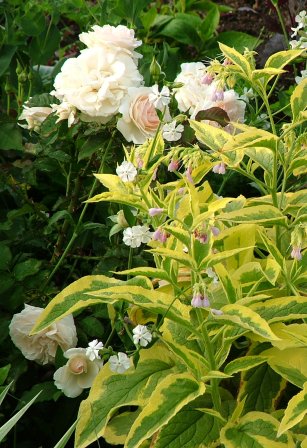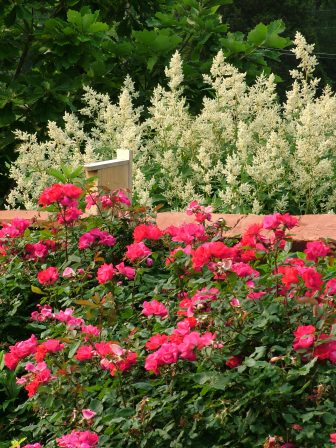A bouquet of buds and blooms to Fran for selecting roses as the GGW Plant Pick of the Month for November! After days of snow showers, chilly winds, and temperatures barely above freezing, I’m so grateful for a reason to sort through my archives for pretty rose pictures.
When I moved to Hayefield nearly nine years ago, I brought several of my favorite roses with me. The very first ones I planted here, even before the house was started, were eight of the original Knock Out (‘Radrazz’), which a dear friend had salvaged from an exhibit at the Philadelphia Flower Show. They lived in a bed in one corner of the field (and looked darn silly out there by themselves) for a year; then, once the house was done, I moved them up to be the foundation planting along the front porch. That lasted another year, then I moved them further out into the front garden (as shown above), where they’ve been happily growing in one spot for six years now. Some years I cut them back to 12 to 18 inches; some years, I don’t prune them at all – whatever I do or don’t do, they are stunning.
Pink Knock Out (‘Radcon’, above) is just as dependable, and it’s a much easier color to work with in the garden, as is the even softer pink Blush Knock Out (‘Radyod’, below). I still like the original hot-pink version best, though.
Another favorite that made the move with me is shown below: a species I acquired as Rosa achburensis from a tiny mail-order nursery that specialized in unusual herbaceous and woody species grown from seed. It flowers in late spring, with single white flowers over beautiful bluish leaves on upright-then-arching canes that create a handsome fountain-like form.
I don’t prize it for the flowers so much, though, because they’re around for barely a week in late spring. But I’m always happy to see the blossoms, because they lead to the plant’s best feature: an abundant crop of relatively large hips that begin turning orange in late summer and then red by late fall. The hips stay on so long that there are usually still some around when the next year’s flowers are opening.
Unfortunately, its days are numbered. I really hoped that it would be spared by the rose rosette disease that’s been giving me problems during the past few years. (I’ve written about RRD before, in Farewell to Roses and Rose Rosette Revisited.) But the symptoms showed up in full force this spring, and nearly every cane is affected, so I guess I’ll be digging it out soon. Sniff.
The eglantine (R. rubiginosa) has it too, but it has many more canes and only a few have shown symptoms. I prune off the damaged ones as soon as I notice them and the rest of the plant looks okay, so maybe I’ll be lucky enough to keep this one around for a while yet. The single pink flowers are charming, but as with R. achburensis, its best feature is the superb show of hips for winter.
Another RRD victim with an uncertain future is ‘Ghislaine de Feligonde’. This Hybrid Multiflora has been a joy to grow, with its clean, bright green foliage and mostly smooth, flexible canes that are easy to wrap around a support – and, of course, because of its clusters of small but abundant peachy yellow blooms that age to ivory white. Below is ‘GdF’ in her full glory a few years ago.
After I cut out all of the canes that showed RRD symptoms this past spring, she was a shadow of her former self this year, and more damage has appeared. I think she’ll be shovel-pruned soon too.
But all is not gloom and doom among the Hayefield roses. The Knock Outs have all been fine so far, thank goodness, and so have many others. Growing right in between the affected R. achburensis and ‘GdF’ is the classic ‘New Dawn’. With her thick, relatively stiff, and decidedly prickly canes, ‘New Dawn’ has been a yearly challenge to keep trained against the porch posts and railings, but she’s worth it.
She’s also been an excellent support for several equally vigorous vines, including Clematis viorna and Lonicera japonica ‘Aureoreticulata’.
On the other side of the side porch is what I believe is ‘Awakening’, which is supposed to be a fully double sport of ‘New Dawn’. It too is sweet mingling with clematis and honeysuckle, and with tall perennials, such as purple ironweed (Vernonia).
When choosing new roses to try, I like to hunt out those that are more than pretty faces. I’m a sucker for great fragrance, for instance. When I was writing the current incarnation of Taylor’s Guide to Roses, I asked an expert rosiarian to look over the manuscript, and the only general objection the reviewer had was my emphasis on scent (or lack thereof) in the cultivar descriptions. But I ask you: What is the first thing a person does when you hand them a rose? They sniff it! I’m willing to put up with less-than-perfect flowers if the fragrance is outstanding. Miniature ‘Sweet Chariot’, for instance, develops brown tips on its blooms as they age, so it can look a little shabby a week or so after its first flush of flowers, but its perfumey fragrance is noticeable even without stooping.
In the spirit of seeking “something different,” I also like to look for other unique features. Bred in the late 1980s, ‘Moore’s Striped Rugosa’ was, I believe, the very first Rugosa Hybrid with striped blooms. The plant itself isn’t particularly good-looking, and the flowers seem prone to turning mushy quickly in damp weather, but there’s usually at least one blossom around at any point during the summer and fall.
Where roses are concerned, “good foliage” usually means that the leaves are not especially prone to disease damage. But there are a few that are definitely desirable for their leaves: blue-leaved (R. glauca), for one.
Considering the reddish young foliage, it’s equally deserving of its alternate name: red-leaved rose (R. rubrifolia).
The single pink flowers in late spring and showy hips in fall and winter are bonus features.
For true foliage fanatics, there are also a couple of rose cultivars with variegated leaves. One is the old Hybrid Tea ‘Verschuren’, with variable white and yellow flecking on a rich green background. It also produces double pink flowers, but the blooms are rather too large for the thin stems and tend to nod. It’s not a rose you’d count on as a beautiful border feature, but it’s cool as a curiosity.
And that brings to mind a cultivar with even more distinct variegation: R. wichurana ‘Curiosity’. Also known as ‘Wichuraiana Variegata’, it grows in a densely twiggy mass of slender green canes, with many tiny leaves flecked and stippled with white. The foliage is also heavily blushed with pink in cooler weather. Single white flowers appear too, but they’re hardly visible against the variegated leaves.
And one more simply for sentiment: the gorgeous Floribunda ‘Guinevere’, in memory of my dear Sheltie Gwennie (who happens to be hiding in the photo of ‘Ghislaine de Feligonde’ above). Here, ‘Guinevere’ mingles with ‘Axminster Gold’ comfrey (Symphytum x uplandicum) and a silene.
I know that many of you have your own beloved roses, and perhaps you too would enjoy thinking and writing about them for this month’s Plant Pick. Feel free to leave a link at Fran’s original post so the rest of us can find you!

